Insurance of International Trade Risks Yulia Y.



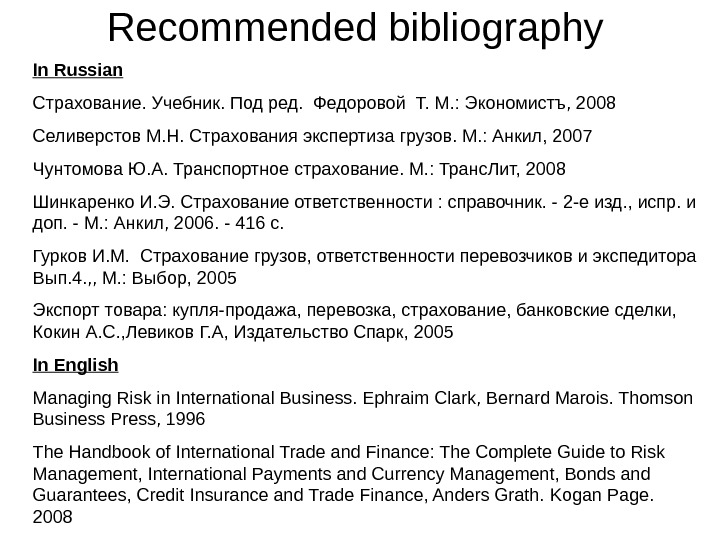
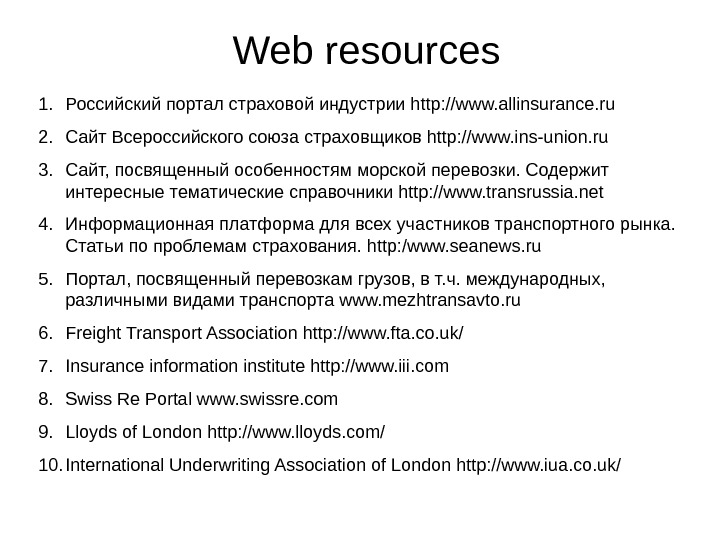














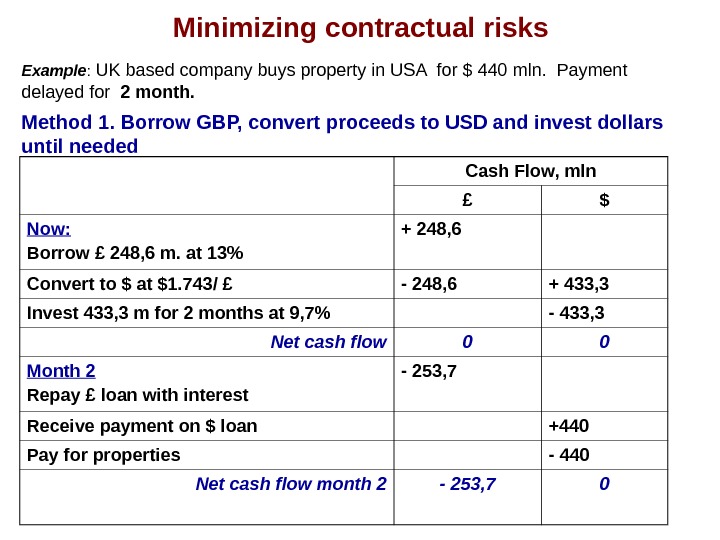

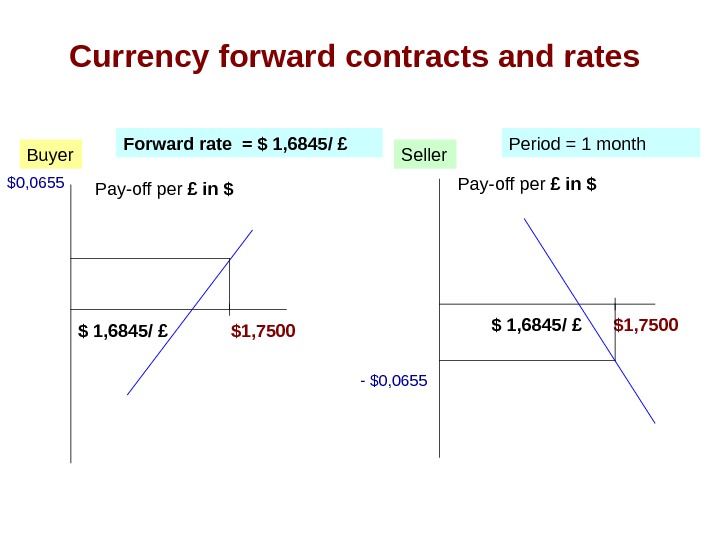












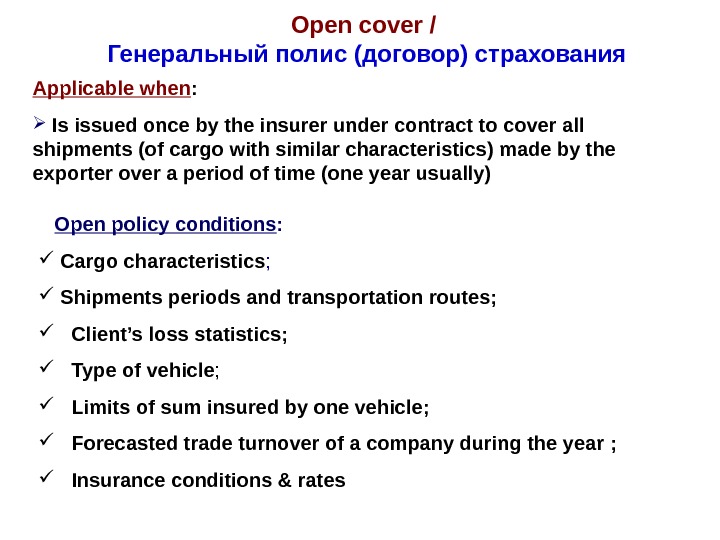
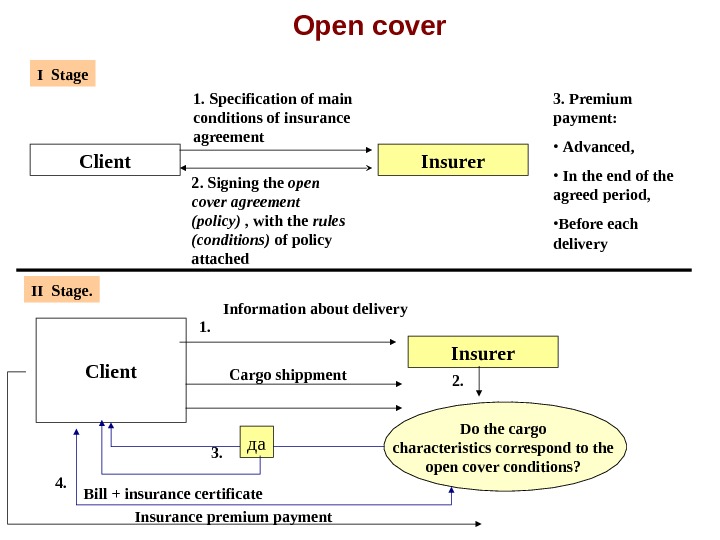
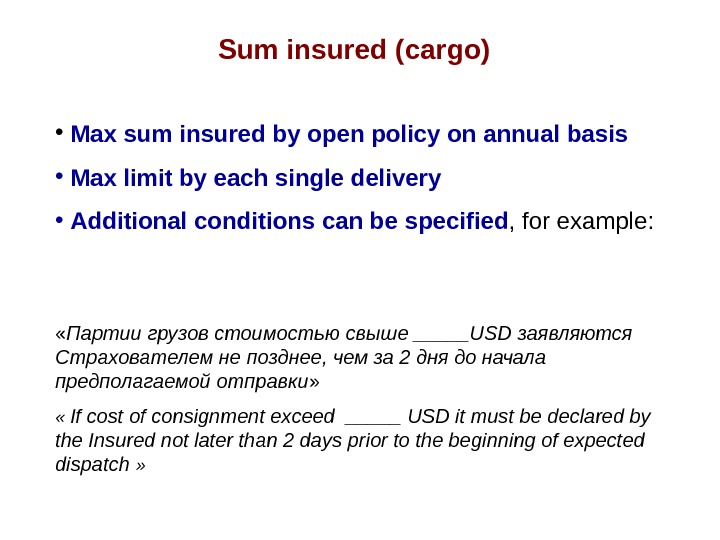






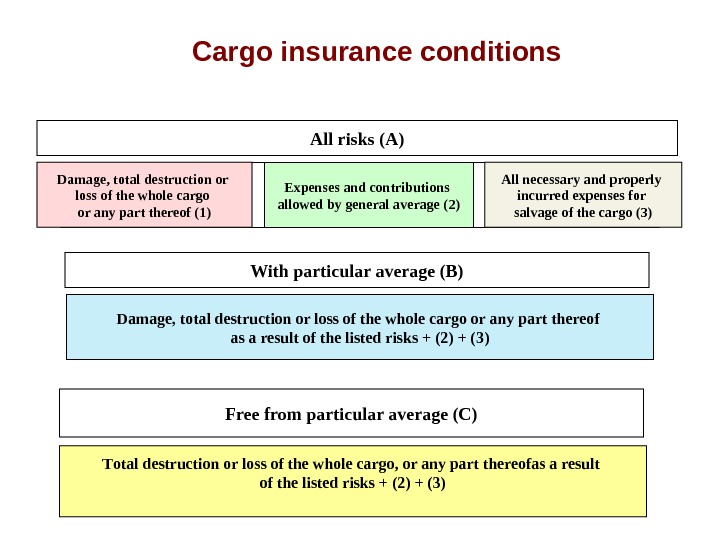










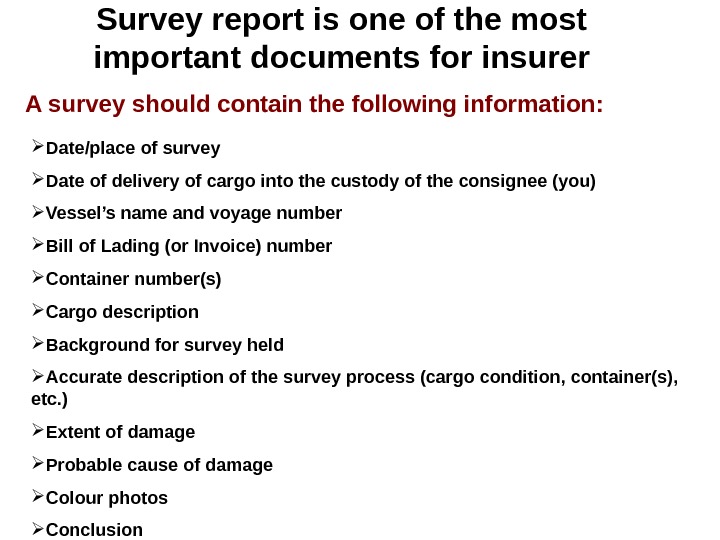
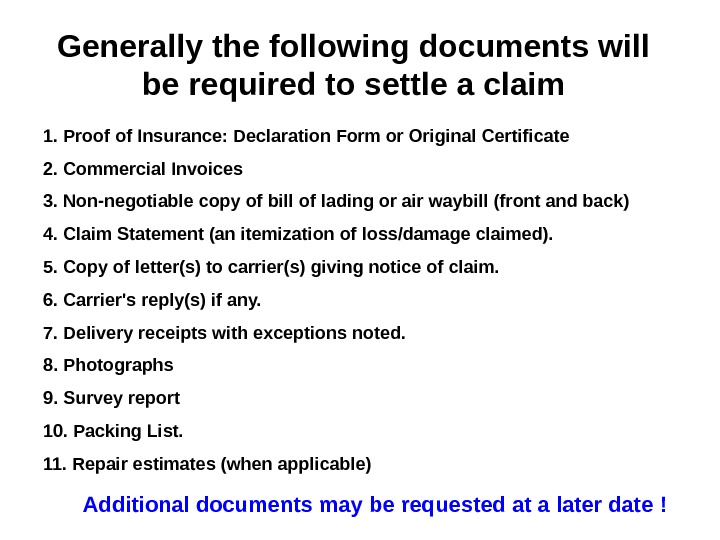


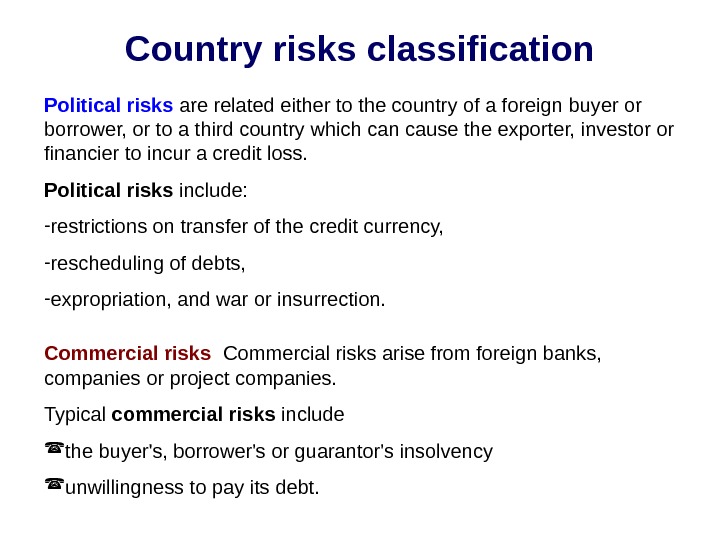

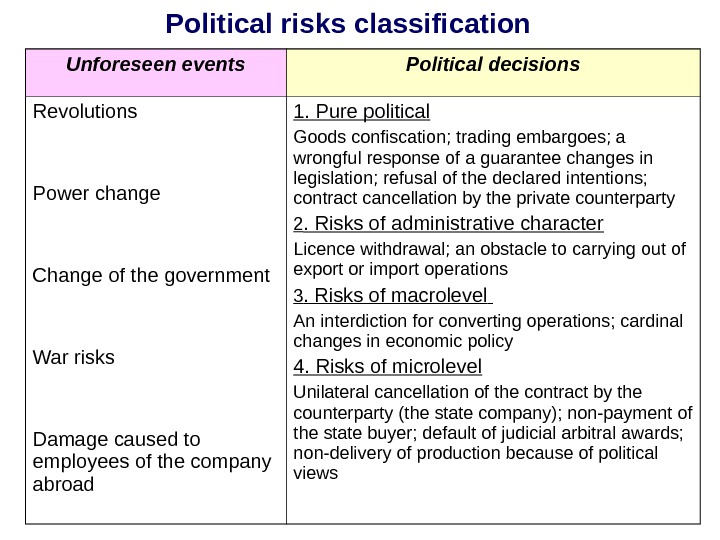
















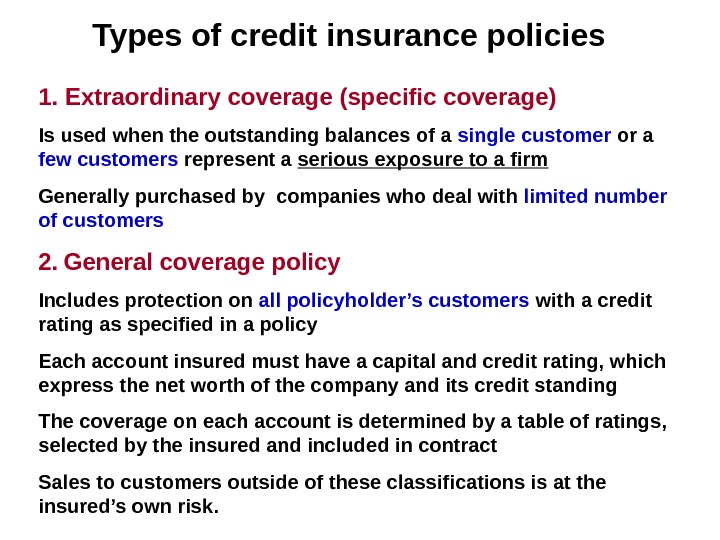


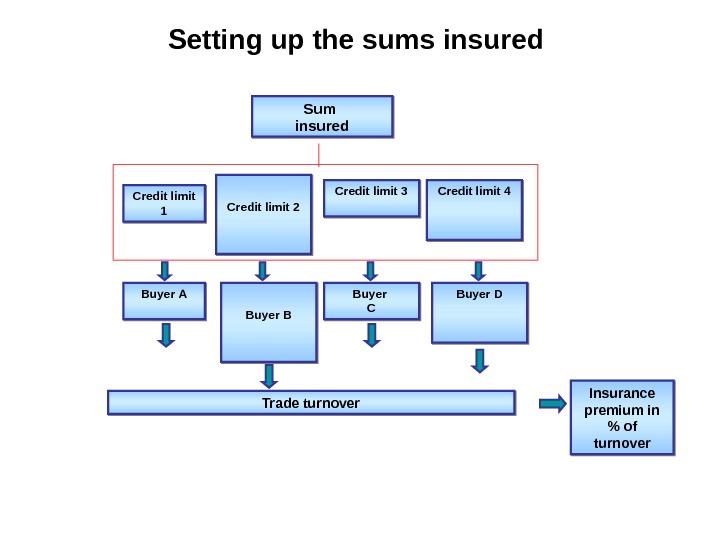
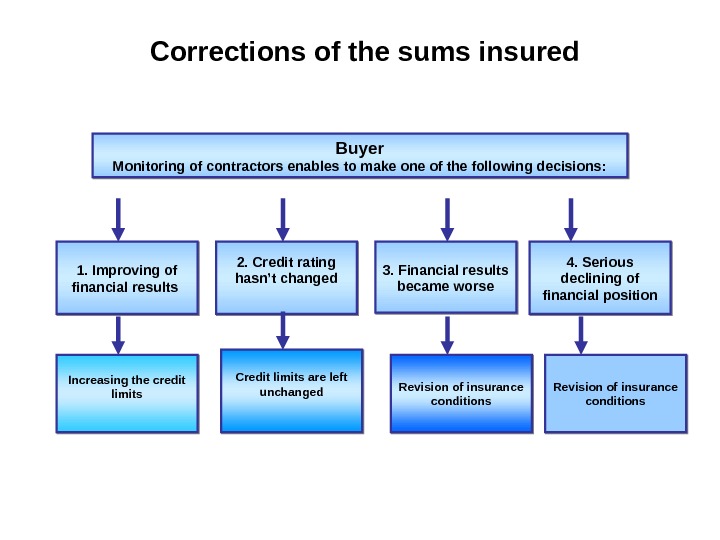

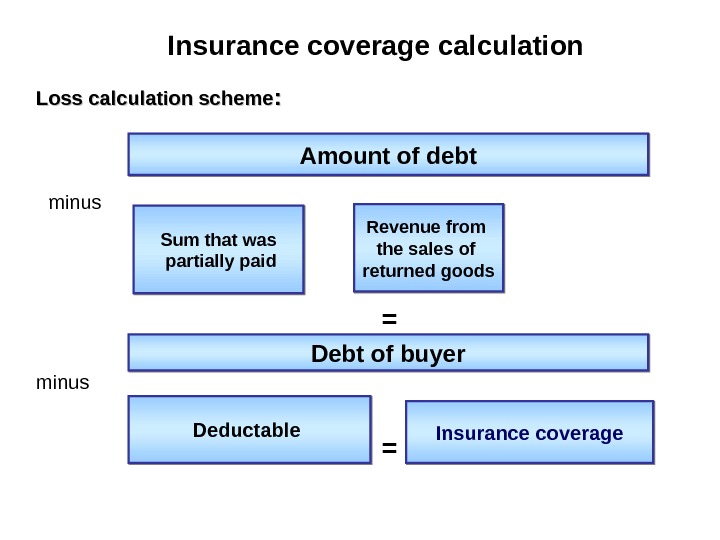






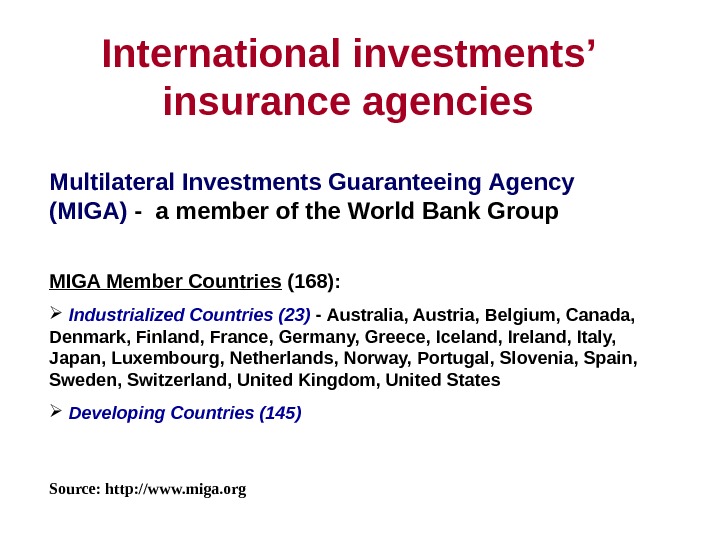

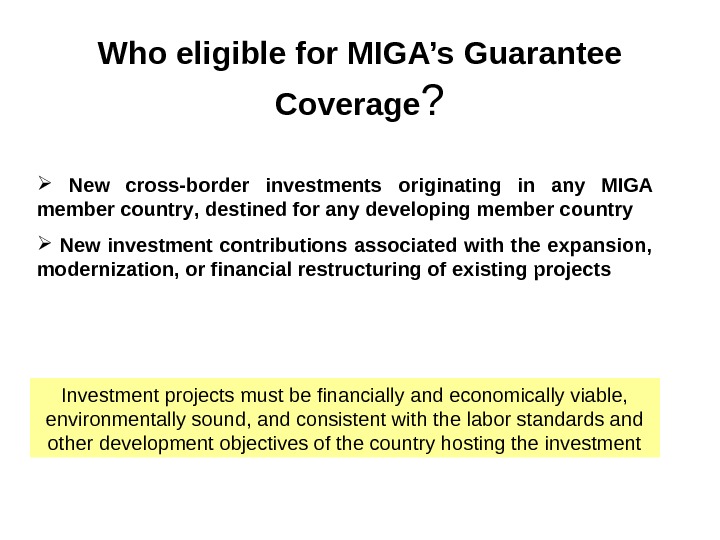

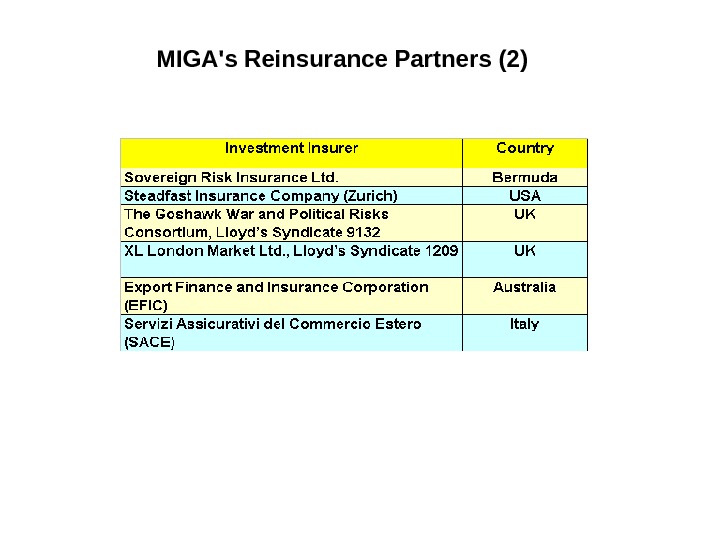

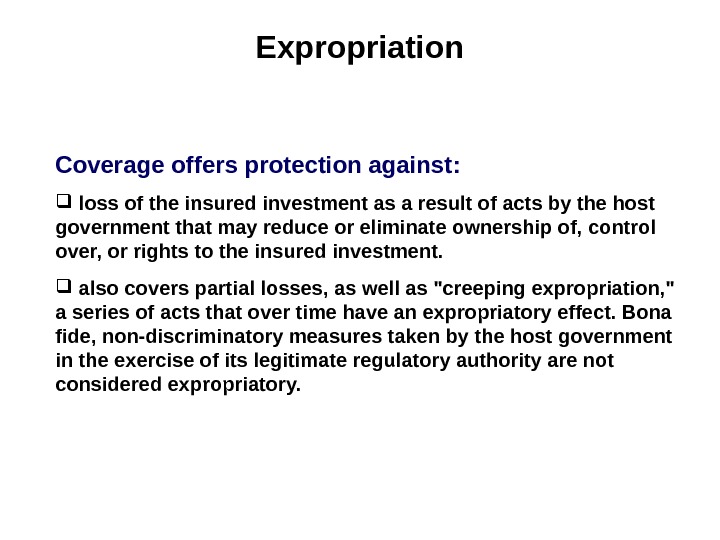
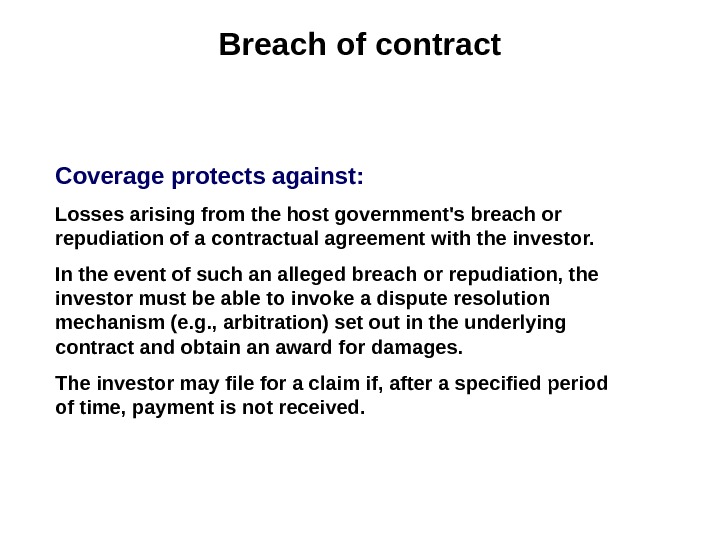

- Размер: 1 Mегабайта
- Количество слайдов: 98
Описание презентации Insurance of International Trade Risks Yulia Y. по слайдам
 Insurance of International Trade Risks Yulia Y. Finogenova (jfinogenova@yandex. ru)
Insurance of International Trade Risks Yulia Y. Finogenova (jfinogenova@yandex. ru)
 Course Structure Date Topic Tasks Sept’ 07 1. Risk management in the international foreign trade operations — Currency risks management — SWOP operations discussion Sep’ 14 2. International cargo and marine insurance Role play: International cargo insurance (rates estimation and handling claims) Sep’ 21 3. Insurance of international investments and credits Presentations Sep’ 28 Pass/fail Examination
Course Structure Date Topic Tasks Sept’ 07 1. Risk management in the international foreign trade operations — Currency risks management — SWOP operations discussion Sep’ 14 2. International cargo and marine insurance Role play: International cargo insurance (rates estimation and handling claims) Sep’ 21 3. Insurance of international investments and credits Presentations Sep’ 28 Pass/fail Examination
 Recommended bibliography In Russian Страхование. Учебник. Под ред. Федоровой Т. М. : Экономистъ, 2008 Селиверстов М. Н. Страхования экспертиза грузов. М. : Анкил, 2007 Чунтомова Ю. А. Транспортное страхование. М. : Транс. Лит, 2008 Шинкаренко И. Э. Страхование ответственности : справочник. — 2 -е изд. , испр. и доп. — М. : Анкил, 2006. — 416 с. Гурков И. М. Страхование грузов, ответственности перевозчиков и экспедитора Вып. 4. , , М. : Выбор, 2005 Экспорт товара: купля-продажа, перевозка, страхование, банковские сделки, Кокин А. С. , Левиков Г. А, Издательство Спарк, 2005 In English Managing Risk in International Business. Ephraim Clark, Bernard Marois. Thomson Business Press, 1996 The Handbook of International Trade and Finance: The Complete Guide to Risk Management, International Payments and Currency Management, Bonds and Guarantees, Credit Insurance and Trade Finance, Anders Grath. Kogan Page.
Recommended bibliography In Russian Страхование. Учебник. Под ред. Федоровой Т. М. : Экономистъ, 2008 Селиверстов М. Н. Страхования экспертиза грузов. М. : Анкил, 2007 Чунтомова Ю. А. Транспортное страхование. М. : Транс. Лит, 2008 Шинкаренко И. Э. Страхование ответственности : справочник. — 2 -е изд. , испр. и доп. — М. : Анкил, 2006. — 416 с. Гурков И. М. Страхование грузов, ответственности перевозчиков и экспедитора Вып. 4. , , М. : Выбор, 2005 Экспорт товара: купля-продажа, перевозка, страхование, банковские сделки, Кокин А. С. , Левиков Г. А, Издательство Спарк, 2005 In English Managing Risk in International Business. Ephraim Clark, Bernard Marois. Thomson Business Press, 1996 The Handbook of International Trade and Finance: The Complete Guide to Risk Management, International Payments and Currency Management, Bonds and Guarantees, Credit Insurance and Trade Finance, Anders Grath. Kogan Page.
 Web resources 1. Российский портал страховой индустрии http: //www. allinsurance. ru 2. Сайт Всероссийского союза страховщиков http: //www. ins-union. ru 3. Сайт, посвященный особенностям морской перевозки. Содержит интересные тематические справочники http: //www. transrussia. net 4. Информационная платформа для всех участников транспортного рынка. Статьи по проблемам страхования. http: /www. seanews. ru 5. Портал, посвященный перевозкам грузов, в т. ч. международных, различными видами транспорта www. mezhtransavto. ru 6. Freight Transport Association http: //www. fta. co. uk/ 7. Insurance information institute http: //www. iii. com 8. Swiss Re Portal www. swissre. com 9. Lloyds of London http: //www. lloyds. com/ 10. International Underwriting Association of London http: //www. iua. co. uk/
Web resources 1. Российский портал страховой индустрии http: //www. allinsurance. ru 2. Сайт Всероссийского союза страховщиков http: //www. ins-union. ru 3. Сайт, посвященный особенностям морской перевозки. Содержит интересные тематические справочники http: //www. transrussia. net 4. Информационная платформа для всех участников транспортного рынка. Статьи по проблемам страхования. http: /www. seanews. ru 5. Портал, посвященный перевозкам грузов, в т. ч. международных, различными видами транспорта www. mezhtransavto. ru 6. Freight Transport Association http: //www. fta. co. uk/ 7. Insurance information institute http: //www. iii. com 8. Swiss Re Portal www. swissre. com 9. Lloyds of London http: //www. lloyds. com/ 10. International Underwriting Association of London http: //www. iua. co. uk/
 1. Risk management in the international foreign trade operations
1. Risk management in the international foreign trade operations
 Risks in International Trade Economic risks Risk of concession in economic control Risk of insolvency of the buyer Risk of non-acceptance Financial Risk of default i. e. the failure of the buyer to pay off the due amount after n-months of the due date Risk of Exchange rate Commercial risk A bank’s lack of ability to fulfill its responsibilities A buyer’s failure pertaining to payment due to financial limitations A seller’s inability to provide the required quantity or quality of goods Political risks Risk of non- renewal of import and exports licenses Risks due to war Risk of the imposition of an import ban after the delivery of the goods Surrendering of political sovereignty Buyer Country risks Exchange control regulations Lack of foreign currency Trade embargoes
Risks in International Trade Economic risks Risk of concession in economic control Risk of insolvency of the buyer Risk of non-acceptance Financial Risk of default i. e. the failure of the buyer to pay off the due amount after n-months of the due date Risk of Exchange rate Commercial risk A bank’s lack of ability to fulfill its responsibilities A buyer’s failure pertaining to payment due to financial limitations A seller’s inability to provide the required quantity or quality of goods Political risks Risk of non- renewal of import and exports licenses Risks due to war Risk of the imposition of an import ban after the delivery of the goods Surrendering of political sovereignty Buyer Country risks Exchange control regulations Lack of foreign currency Trade embargoes
 Risk Management Tools Loss Control Loss Financing Internal Risk Reduction Loss reduction activities Loss prevention activities Retention and self –insurance (reserves) Insurance Hedging Other contractual risk transfers Diversification Investments in the information Loss Transfer Loss Avoidance
Risk Management Tools Loss Control Loss Financing Internal Risk Reduction Loss reduction activities Loss prevention activities Retention and self –insurance (reserves) Insurance Hedging Other contractual risk transfers Diversification Investments in the information Loss Transfer Loss Avoidance
 Most popular risk management instruments — A documentary letter of credit offers the best protection for overseas commercial transactions — The correct derivatives guarantee cover against the exchange rate exposure
Most popular risk management instruments — A documentary letter of credit offers the best protection for overseas commercial transactions — The correct derivatives guarantee cover against the exchange rate exposure
 How a documentary letter of credit works? 1. A documentary letter of credit is opened by the purchaser’s local bank (the credit-opening bank). 2. Via the credit-transmitting bank, the documentary letter of credit reaches the vendor. It checks whether the terms of the documentary letter of credit match the terms of your commercial contract. Only if the vendor is convinced can he send the goods to the purchaser. 3. The necessary documents (invoice, transport document, insurance documents) are handed over by the vendor to the credit-transmitting bank. After checking these documents, the credit-transmitting bank pays the sum that the purchaser owes to the vendor directly. 4. The credit-transmitting bank sends the documents to the credit-opening bank that, after checking the documents in turn, pays the amount due to the credit-transmitting bank. 5. Via the credit-opening bank, the documents finally reach the purchaser, who can use these documents to collect the shipped goods. 6. Finally, the buyer pays the amount owed to the local bank.
How a documentary letter of credit works? 1. A documentary letter of credit is opened by the purchaser’s local bank (the credit-opening bank). 2. Via the credit-transmitting bank, the documentary letter of credit reaches the vendor. It checks whether the terms of the documentary letter of credit match the terms of your commercial contract. Only if the vendor is convinced can he send the goods to the purchaser. 3. The necessary documents (invoice, transport document, insurance documents) are handed over by the vendor to the credit-transmitting bank. After checking these documents, the credit-transmitting bank pays the sum that the purchaser owes to the vendor directly. 4. The credit-transmitting bank sends the documents to the credit-opening bank that, after checking the documents in turn, pays the amount due to the credit-transmitting bank. 5. Via the credit-opening bank, the documents finally reach the purchaser, who can use these documents to collect the shipped goods. 6. Finally, the buyer pays the amount owed to the local bank.
 1. After a contract is concluded between buyer and seller, buyer’s bank supplies a letter of credit to seller L
1. After a contract is concluded between buyer and seller, buyer’s bank supplies a letter of credit to seller L
 2. Seller consigns the goods to a carrier in exchange for a bill of lading Goods Bill of lading (BL)
2. Seller consigns the goods to a carrier in exchange for a bill of lading Goods Bill of lading (BL)
 Seller put bill of lading for payment from buyer’s bank. Buyer’s bank exchanges bill of lading for payment from the buyer. BL BL Payment BLPayment
Seller put bill of lading for payment from buyer’s bank. Buyer’s bank exchanges bill of lading for payment from the buyer. BL BL Payment BLPayment
 Buyer provides bill of lading to carrier and takes delivery of goods Goods BL
Buyer provides bill of lading to carrier and takes delivery of goods Goods BL
 Exchange rate exposure You make forward purchases of foreign currencies and wish to protect yourself against unfavourable trends in the foreign currencies that you have to buy. You make forward sales of foreign currencies and wish to protect yourself against unfavourable trends in the foreign currencies that you have to sell.
Exchange rate exposure You make forward purchases of foreign currencies and wish to protect yourself against unfavourable trends in the foreign currencies that you have to buy. You make forward sales of foreign currencies and wish to protect yourself against unfavourable trends in the foreign currencies that you have to sell.
 Participants of the financial markets and their interests Currency Markets Buyers (importers)Foreign currency exchange rates growth Foreign currency exchange rates decline Sellers (exporters) Foreign currency exchange rates growth Borrowers (in foreign currency) Foreign currency exchange rates decline Lenders (in foreign currency)
Participants of the financial markets and their interests Currency Markets Buyers (importers)Foreign currency exchange rates growth Foreign currency exchange rates decline Sellers (exporters) Foreign currency exchange rates growth Borrowers (in foreign currency) Foreign currency exchange rates decline Lenders (in foreign currency)
 Participants of the financial markets and their interests Commodity Markets Commodities price growth Commodities price decline Commodities price growth Commodities buyers Commodities sellers Investors Credit Markets Rates growth Borrowers Rates decline Lenders
Participants of the financial markets and their interests Commodity Markets Commodities price growth Commodities price decline Commodities price growth Commodities buyers Commodities sellers Investors Credit Markets Rates growth Borrowers Rates decline Lenders
 Currency appreciations and depreciations Previous Exchange Rate (X): Currency A/ Currency B Current Exchange Rate (Y): Currency A/ Currency B If X > Y ( X – Y > 0), Currency A has appreciated and Currency B has depreciated, relative to one another If X < Y ( X – Y < 0), Currency A has depreciated and Currency B has appreciated , relative to one another
Currency appreciations and depreciations Previous Exchange Rate (X): Currency A/ Currency B Current Exchange Rate (Y): Currency A/ Currency B If X > Y ( X – Y > 0), Currency A has appreciated and Currency B has depreciated, relative to one another If X < Y ( X – Y < 0), Currency A has depreciated and Currency B has appreciated , relative to one another
 Foreign currency exchange rate risks Translation risks Arising from the ownership of operating companies outside the home country. The greater the proportion of asset, liability and equity classes denominated in a foreign currency, the greater the translation risk. Transaction risks (contractual risks) Arising from the time delay between entering into a contract and settling it. The greater the time differential between the entrance and settlement of the contract, the greater the transaction risk, because there is more time for the two exchange rates to fluctuate Non contractual risks Arise because exchange rate fluctuations can affect the competitive position of the firm
Foreign currency exchange rate risks Translation risks Arising from the ownership of operating companies outside the home country. The greater the proportion of asset, liability and equity classes denominated in a foreign currency, the greater the translation risk. Transaction risks (contractual risks) Arising from the time delay between entering into a contract and settling it. The greater the time differential between the entrance and settlement of the contract, the greater the transaction risk, because there is more time for the two exchange rates to fluctuate Non contractual risks Arise because exchange rate fluctuations can affect the competitive position of the firm
 Minimizing contractual risks Example : UK based company buys property in USA for $ 440 mln. Payment delayed for 2 month. Method 1. Borrow GBP, convert proceeds to USD and invest dollars until needed Cash Flow, mln £ $ Now: Borrow £ 248, 6 m. at 13% + 248, 6 Convert to $ at $1. 743/ £ — 248, 6 + 433, 3 Invest 433, 3 m for 2 months at 9, 7% — 433, 3 Net cash flow 0 0 Month 2 Repay £ loan with interest — 253, 7 Receive payment on $ loan +440 Pay for properties — 440 Net cash flow month 2 — 253,
Minimizing contractual risks Example : UK based company buys property in USA for $ 440 mln. Payment delayed for 2 month. Method 1. Borrow GBP, convert proceeds to USD and invest dollars until needed Cash Flow, mln £ $ Now: Borrow £ 248, 6 m. at 13% + 248, 6 Convert to $ at $1. 743/ £ — 248, 6 + 433, 3 Invest 433, 3 m for 2 months at 9, 7% — 433, 3 Net cash flow 0 0 Month 2 Repay £ loan with interest — 253, 7 Receive payment on $ loan +440 Pay for properties — 440 Net cash flow month 2 — 253,
 Minimizing contractual risks Method 2. Buy dollars forward Cash Flow, mln £ $ Now: Buy $ 440 m forward at $1. 73 / £ 0 0 Month 2 Pay for $ — 254, 3 +440 Pay for properties — 440 Net cash Flow month 2 -254, 3 0 Cost of hedging = Forward rate – Expected spot rate
Minimizing contractual risks Method 2. Buy dollars forward Cash Flow, mln £ $ Now: Buy $ 440 m forward at $1. 73 / £ 0 0 Month 2 Pay for $ — 254, 3 +440 Pay for properties — 440 Net cash Flow month 2 -254, 3 0 Cost of hedging = Forward rate – Expected spot rate
 Currency forward contracts and rates $0, 0655 Pay-off per £ in $Buyer Seller. Forward rate = $ 1, 6845/ £ $1, 7500 $ 1, 6845/ £ — $0, 0655 $ 1, 6845/ £Period = 1 month
Currency forward contracts and rates $0, 0655 Pay-off per £ in $Buyer Seller. Forward rate = $ 1, 6845/ £ $1, 7500 $ 1, 6845/ £ — $0, 0655 $ 1, 6845/ £Period = 1 month
 Forward premium Fair Forward Exchange Rate = Spot rate * ( 1 + R for) / ( 1 + R home) where, R for – risk free rate abroad R home – domestic risk free rate Suppose, current spot on SFr is $0, 5800 / SFr (or SFr 1, 7241 /$) 1 year risk free rate for borrowing in SFr = 5%, in USD = 6%. One year forward rate = 1, 7241 * 1, 05/1, 06 = SFr 1, 7078 /$ Price of Forward Exchange Contract (in %) = (Forward price – Spot price) / Spot price
Forward premium Fair Forward Exchange Rate = Spot rate * ( 1 + R for) / ( 1 + R home) where, R for – risk free rate abroad R home – domestic risk free rate Suppose, current spot on SFr is $0, 5800 / SFr (or SFr 1, 7241 /$) 1 year risk free rate for borrowing in SFr = 5%, in USD = 6%. One year forward rate = 1, 7241 * 1, 05/1, 06 = SFr 1, 7078 /$ Price of Forward Exchange Contract (in %) = (Forward price – Spot price) / Spot price
 Hedging with currency forward contracts UK company expects to receive SFr 10 mln in 90 days Spot ex. rate currently = £ 0. 6050/ SFr (SFr 1. 6529/ £ ) Three month forward rate for SFr = £ 0. 6051/ SFr (SFr 1. 6526/ £ ) 1) If spot declines to £ 0. 5800/ SFr what will be effect of hedging? 2) What are costs of hedging for UK company?
Hedging with currency forward contracts UK company expects to receive SFr 10 mln in 90 days Spot ex. rate currently = £ 0. 6050/ SFr (SFr 1. 6529/ £ ) Three month forward rate for SFr = £ 0. 6051/ SFr (SFr 1. 6526/ £ ) 1) If spot declines to £ 0. 5800/ SFr what will be effect of hedging? 2) What are costs of hedging for UK company?
 SWAPS & Interest rate risks SWAPS – arrangement by two counterparties to exchange one stream of cash flows for another. London inter bank offer rate (LIBOR) 7, 5% 8, 0% 8, 5% Interest paid on floating rate bond (= LIBOR * $ 100 mln) $ 7 500 000 $ 8 500 000 + Cash payment on SWAP [(= 0, 08 –LIBOR)] * notional principal $100 mln 500 0 -500 000 Total payment on bond with swap agreement $ 8 000 000 $ 8 000 Company issues floating rate bonds (payments = LIBOR * notional principal $100 mln) LIBOR -? If LIBOR 8, 5% company has losses (-500 000) Company has an agreement with dealer to pay LIBOR * 8% if rates less than 8%. Dealer pays LIBOR * 8% if rates higher than 8%. Interest rate swap can transform floating rate bonds into synthetic fixed rate bonds
SWAPS & Interest rate risks SWAPS – arrangement by two counterparties to exchange one stream of cash flows for another. London inter bank offer rate (LIBOR) 7, 5% 8, 0% 8, 5% Interest paid on floating rate bond (= LIBOR * $ 100 mln) $ 7 500 000 $ 8 500 000 + Cash payment on SWAP [(= 0, 08 –LIBOR)] * notional principal $100 mln 500 0 -500 000 Total payment on bond with swap agreement $ 8 000 000 $ 8 000 Company issues floating rate bonds (payments = LIBOR * notional principal $100 mln) LIBOR -? If LIBOR 8, 5% company has losses (-500 000) Company has an agreement with dealer to pay LIBOR * 8% if rates less than 8%. Dealer pays LIBOR * 8% if rates higher than 8%. Interest rate swap can transform floating rate bonds into synthetic fixed rate bonds
 Fixed for floating swaps Notional principal = $ 10 mln Semi annual net CF for fixed rate payer , $ Semi annual net CF for floating payer, $ 6 month LIBOR 0$ 25 000 — $ 50 000 $ 42 500 — $ 32 5008, 5%8%7% 6 month LIBOR 7% 8% 8, 5%
Fixed for floating swaps Notional principal = $ 10 mln Semi annual net CF for fixed rate payer , $ Semi annual net CF for floating payer, $ 6 month LIBOR 0$ 25 000 — $ 50 000 $ 42 500 — $ 32 5008, 5%8%7% 6 month LIBOR 7% 8% 8, 5%
 Example of currency swap US based company A is going to invest in Germany in EURO Germany based company B is going to invest in USA in USD US based company A issues bonds in USA and collects $ 7 mln. to finance deal in Germany German based company B issues bonds in Germany and collects € 10 mln. to finance deal in the USA Intermediary. Fixed exchange rate payer, US based company A Fixed exchange rate payer, German based company BFixed exchange rate In swap = $ 0, 7/ € At the end of 6 months US Comp pays: $ 7 mln. * 0, 08 2 = $ 280 000 * 1, 7 = 400 000 EUR 8% rate, 10 years At the end of 6 months German Comp pays: € 10 mln. * 0, 08 2 = € 40 0 000 * 0, 7 = 280 000 EUR
Example of currency swap US based company A is going to invest in Germany in EURO Germany based company B is going to invest in USA in USD US based company A issues bonds in USA and collects $ 7 mln. to finance deal in Germany German based company B issues bonds in Germany and collects € 10 mln. to finance deal in the USA Intermediary. Fixed exchange rate payer, US based company A Fixed exchange rate payer, German based company BFixed exchange rate In swap = $ 0, 7/ € At the end of 6 months US Comp pays: $ 7 mln. * 0, 08 2 = $ 280 000 * 1, 7 = 400 000 EUR 8% rate, 10 years At the end of 6 months German Comp pays: € 10 mln. * 0, 08 2 = € 40 0 000 * 0, 7 = 280 000 EUR
 Risk Hedging, Risk Management and Value Valuation Component Effect of Risk Hedging Effect of Risk Management Costs of equity and capital Reduce cost of equity for private and closely held firms. Reduce cost of debt for heavily levered firms with significant distress risk May increase costs of equity and capital, if firms increases its exposure to risks where it feels it has a differential advantage. Cash flow to the Firm Cost of risk hedging will reduce earnings. Smoothing out earnings may reduce taxes paid over time. More effective risk management may increase operating margins and increase cash flows. Expected Growth rate during high growth period Reducing risk exposure may make managers more comfortable taking risky (and good) investments. Increase in reinvestment rate will increase growth. Exploiting opportunities created by risk will allow the firm to earn a higher return on capital on its new investments. Length of high growth period No effect Strategic risk management can be a long-term competitive advantage and increase length of growth period.
Risk Hedging, Risk Management and Value Valuation Component Effect of Risk Hedging Effect of Risk Management Costs of equity and capital Reduce cost of equity for private and closely held firms. Reduce cost of debt for heavily levered firms with significant distress risk May increase costs of equity and capital, if firms increases its exposure to risks where it feels it has a differential advantage. Cash flow to the Firm Cost of risk hedging will reduce earnings. Smoothing out earnings may reduce taxes paid over time. More effective risk management may increase operating margins and increase cash flows. Expected Growth rate during high growth period Reducing risk exposure may make managers more comfortable taking risky (and good) investments. Increase in reinvestment rate will increase growth. Exploiting opportunities created by risk will allow the firm to earn a higher return on capital on its new investments. Length of high growth period No effect Strategic risk management can be a long-term competitive advantage and increase length of growth period.
 2. International cargo and marine insurance
2. International cargo and marine insurance
 Plan of the lecture Structure of insurance programs Forms of insurance agreements International Cargo Clauses Carrier’s liability insurance Specific of handling claims
Plan of the lecture Structure of insurance programs Forms of insurance agreements International Cargo Clauses Carrier’s liability insurance Specific of handling claims
 Insurance programs foreign trade organizations INSURABLE RISKS Hull Cargo Carrier’s Liability D amage, total destruction or loss of the carrying conveyance D amage, total destruction or loss of the cargo Liability to the third parties for the financial losses
Insurance programs foreign trade organizations INSURABLE RISKS Hull Cargo Carrier’s Liability D amage, total destruction or loss of the carrying conveyance D amage, total destruction or loss of the cargo Liability to the third parties for the financial losses
 Who are interested in transportation of cargo insurance? • Importers , buying on FOB & CPT conditions • Exporters , selling on CIF/CIP conditions • International traders ( buying in one country and selling to another country ) • Goods producers , purchasing raw materials and selling finished goods • Distributors • Transportation and Stock Companies , who has a contract liability to buy insurance for clients’ cargo
Who are interested in transportation of cargo insurance? • Importers , buying on FOB & CPT conditions • Exporters , selling on CIF/CIP conditions • International traders ( buying in one country and selling to another country ) • Goods producers , purchasing raw materials and selling finished goods • Distributors • Transportation and Stock Companies , who has a contract liability to buy insurance for clients’ cargo
 Forms of insurance agreements
Forms of insurance agreements
 Single insurance policy / Разовый полис страхования Valid for one shipping Valid for a period from 30 to 60 days from the date of insurance premium payment Fact of shipment must be documentary confirmed by the insured In case of delay in delivery, insurance premium has to be retuned by the insurer to the client (minus insurance loading)Features :
Single insurance policy / Разовый полис страхования Valid for one shipping Valid for a period from 30 to 60 days from the date of insurance premium payment Fact of shipment must be documentary confirmed by the insured In case of delay in delivery, insurance premium has to be retuned by the insurer to the client (minus insurance loading)Features :
 Open cover / Генеральный полис (договор) страхования Applicable when : Is issued once by the insurer under contract to cover all shipments (of cargo with similar characteristics) made by the exporter over a period of time (one year usually) Open policy conditions : Cargo characteristics ; Shipments periods and transportation route s ; Client’s loss statistics ; Type of vehicle ; Limits of sum insured by one vehicle ; Forecasted trade turnover of a company during the year ; Insurance conditions & rates
Open cover / Генеральный полис (договор) страхования Applicable when : Is issued once by the insurer under contract to cover all shipments (of cargo with similar characteristics) made by the exporter over a period of time (one year usually) Open policy conditions : Cargo characteristics ; Shipments periods and transportation route s ; Client’s loss statistics ; Type of vehicle ; Limits of sum insured by one vehicle ; Forecasted trade turnover of a company during the year ; Insurance conditions & rates
 Open cover Client Insurer 1. Specification of main conditions of insurance agreement 2. Signing the open cover agreement (policy) , with the rules (conditions) of policy attached Client Cargo shippment Insurer Do the cargo characteristics correspond to the open cover conditions? да Bill + insurance certificate 1. 2. 3. Insurance premium payment. I Stage II Stage. Information about delivery 4. 3. Premium payment : • Advanced , • In the end of the agreed period , • Before each delivery
Open cover Client Insurer 1. Specification of main conditions of insurance agreement 2. Signing the open cover agreement (policy) , with the rules (conditions) of policy attached Client Cargo shippment Insurer Do the cargo characteristics correspond to the open cover conditions? да Bill + insurance certificate 1. 2. 3. Insurance premium payment. I Stage II Stage. Information about delivery 4. 3. Premium payment : • Advanced , • In the end of the agreed period , • Before each delivery
 Sum insured ( cargo ) • Max sum insured by open policy on annual basis • Max limit by each single delivery • Additional conditions can be specified , for example : « Партии грузов стоимостью свыше _____USD заявляются Страхователем не позднее, чем за 2 дня до начала предполагаемой отправки » « If cost of consignment exceed _____ USD it must be declared by the Insured not later than 2 days prior to the beginning of expected dispatch »
Sum insured ( cargo ) • Max sum insured by open policy on annual basis • Max limit by each single delivery • Additional conditions can be specified , for example : « Партии грузов стоимостью свыше _____USD заявляются Страхователем не позднее, чем за 2 дня до начала предполагаемой отправки » « If cost of consignment exceed _____ USD it must be declared by the Insured not later than 2 days prior to the beginning of expected dispatch »
 Open cover (frequent deliveries) Client Insurer. During the month : Cargo shipments Акцепт (Страховой сертификат) / Issue of insurance certificate for each accepted shipment В конце месяца страхования (обычно — не позднее пятого рабочего дня месяца, следующего за отчетным) / in the end of month — Deposit withdrawal Бордеро – подробные сведения об отдельных отправках* / List of shipments’ details — Bill (страховая сумма по всем перевезенным грузам * тариф) * — По требованию страховщика — копии документов (инвойсов, коносаментов и т. п. ), подтверждающих стоимость каждой единицы товара и их количество по каждой отправке
Open cover (frequent deliveries) Client Insurer. During the month : Cargo shipments Акцепт (Страховой сертификат) / Issue of insurance certificate for each accepted shipment В конце месяца страхования (обычно — не позднее пятого рабочего дня месяца, следующего за отчетным) / in the end of month — Deposit withdrawal Бордеро – подробные сведения об отдельных отправках* / List of shipments’ details — Bill (страховая сумма по всем перевезенным грузам * тариф) * — По требованию страховщика — копии документов (инвойсов, коносаментов и т. п. ), подтверждающих стоимость каждой единицы товара и их количество по каждой отправке
 Open cover Advantages : — decreasing the administrative costs — all the shipments automatically insured for 1 year — 20 – 30% chipper than the single policy Disadvantages : — cooperation only with one insurer during the whole year Sum insured : Forecasted invoice cost of cargo + All the transportation expenses* * — Expenses on the freight, customs clearance fee, expenses on the armed support etc.
Open cover Advantages : — decreasing the administrative costs — all the shipments automatically insured for 1 year — 20 – 30% chipper than the single policy Disadvantages : — cooperation only with one insurer during the whole year Sum insured : Forecasted invoice cost of cargo + All the transportation expenses* * — Expenses on the freight, customs clearance fee, expenses on the armed support etc.
 What factors influence on the amount of the insurance rate and cost of insurance? Insurance Conditions (А, В, С — ICC ) Type of the cargo and the probability of its damage Packing quality and its meet to the character of cargo Character of Transportation Type of the Vehicle Seasonal Factors Distance, expeditors accompaniment The number of re-loadings in transit Length of the period of insurance Size of deductible
What factors influence on the amount of the insurance rate and cost of insurance? Insurance Conditions (А, В, С — ICC ) Type of the cargo and the probability of its damage Packing quality and its meet to the character of cargo Character of Transportation Type of the Vehicle Seasonal Factors Distance, expeditors accompaniment The number of re-loadings in transit Length of the period of insurance Size of deductible
 International Cargo Clauses (ICC)
International Cargo Clauses (ICC)
 A, B, C Clauses of ICC — Institute Cargo C l auses (Institute of London Undewriters) С = 0, 2 – 0, 4% В = 0, 4 – 0, 6% А = 0, 6 – 0, 8%Insurance premium (in % of the Sum insured) C B А Risks and Insurance coverage A ll risks e xclusions exclusions
A, B, C Clauses of ICC — Institute Cargo C l auses (Institute of London Undewriters) С = 0, 2 – 0, 4% В = 0, 4 – 0, 6% А = 0, 6 – 0, 8%Insurance premium (in % of the Sum insured) C B А Risks and Insurance coverage A ll risks e xclusions exclusions
 Cargo insurance conditions Clauses cover all risks of loss of or damage (All risks) Clauses cover the risks of loss of or damage except (list 1) (With particular average) Clauses cover the risks of loss of or damage except (list 2) ( Free from particular average) Risks of storage
Cargo insurance conditions Clauses cover all risks of loss of or damage (All risks) Clauses cover the risks of loss of or damage except (list 1) (With particular average) Clauses cover the risks of loss of or damage except (list 2) ( Free from particular average) Risks of storage
 Cargo insurance conditions All risks (A) D amage, total destruction or loss of the whole cargo or any part thereof (1) E xpenses and contributions allowed by general average (2) A ll necessary and properly incurred expenses for salvage of the cargo (3) With particular average (B) D amage, total destruction or loss of the whole cargo or any part thereof as a result of the listed risks + (2) + (3) Free from particular average (C) T otal destruction or loss of the whole cargo, or any part thereof as a result of the listed risks + (2) + (3)
Cargo insurance conditions All risks (A) D amage, total destruction or loss of the whole cargo or any part thereof (1) E xpenses and contributions allowed by general average (2) A ll necessary and properly incurred expenses for salvage of the cargo (3) With particular average (B) D amage, total destruction or loss of the whole cargo or any part thereof as a result of the listed risks + (2) + (3) Free from particular average (C) T otal destruction or loss of the whole cargo, or any part thereof as a result of the listed risks + (2) + (3)
 Comparative analysis of ICC coverages
Comparative analysis of ICC coverages
 Carrier’s liability insurance
Carrier’s liability insurance
 Insurance of liability for international transportation organizations Responsibility to cargo damage ( including insurance within the limits of convention КДПГ 1956). Risks: destruction, loss of cargo in case of road accident, a fire, overturning of a vehicle, theft Responsibility for the financial losses connected with consequences of omissions of transport company’s employees. Risks: delay in delivery , wrong send of cargo, failure to carry out of instructions of the sender, wrong official registration of papers etc. Responsibility to the third parties. Risks : a damage caused by cargo to property, life and/or health of individuals or business, surrounding environment Warranty insurance TIR (a financial guarantee for customs in auto transportations). Risks: Responsibility for payment of customs fees to premises of the goods under a customs regime (the Insurance sum amounted USD 50 000 under one TIR carnet). Responsibility to customs in the international transportation of cargoes with application of TIR carnets or other customs’ papers.
Insurance of liability for international transportation organizations Responsibility to cargo damage ( including insurance within the limits of convention КДПГ 1956). Risks: destruction, loss of cargo in case of road accident, a fire, overturning of a vehicle, theft Responsibility for the financial losses connected with consequences of omissions of transport company’s employees. Risks: delay in delivery , wrong send of cargo, failure to carry out of instructions of the sender, wrong official registration of papers etc. Responsibility to the third parties. Risks : a damage caused by cargo to property, life and/or health of individuals or business, surrounding environment Warranty insurance TIR (a financial guarantee for customs in auto transportations). Risks: Responsibility for payment of customs fees to premises of the goods under a customs regime (the Insurance sum amounted USD 50 000 under one TIR carnet). Responsibility to customs in the international transportation of cargoes with application of TIR carnets or other customs’ papers.
 Claim cover limitations (cargo damage) Type of transportation Reimbursement for 1 kg of damaged or lost cargo Declared interest option International Conventions regulated Auto transportation 8, 33 SDR* + The convention on the agreement of the international road transportation of cargoes (КДПГ 1978) Railway transportation 17 SDR + The convention on the international rail transportation (КОТИФ 1980) Sea transportation 2 – 2, 5 SDR — The Hamburg rules (1978) Amendments to the Hague Rules / to the Visbijsky report Aviation transportation 17 SDR + Montreal protocols (1975) * — The SDR is an international reserve asset, created by the IMF in
Claim cover limitations (cargo damage) Type of transportation Reimbursement for 1 kg of damaged or lost cargo Declared interest option International Conventions regulated Auto transportation 8, 33 SDR* + The convention on the agreement of the international road transportation of cargoes (КДПГ 1978) Railway transportation 17 SDR + The convention on the international rail transportation (КОТИФ 1980) Sea transportation 2 – 2, 5 SDR — The Hamburg rules (1978) Amendments to the Hague Rules / to the Visbijsky report Aviation transportation 17 SDR + Montreal protocols (1975) * — The SDR is an international reserve asset, created by the IMF in
 Special Drawing Rights (SDR) Valuation. Friday, September 10, 2010 Currency amount under Rule O-1 Exchange rate 1 U. S. dollar equivalent Percent change in exchange rate against U. S. dollar from previous calculation Euro 0. 4100 1. 27290 0. 521889 0. 024 Japanese yen 18. 4000 83. 99000 0. 219074 -0. 381 Pound sterling 0. 0903 1. 54560 0. 139568 0. 279 U. S. dollar 0. 6320 1. 00000 0. 632000 1. 512531 U. S. $1. 00 = SDR 0. 661143 2 0. 021 3 SDR 1 = US$ 1. 51253 4 It is calculated as the sum of specific amounts of the four currencies valued in U. S. dollars, on the basis of exchange rates quoted at noon each day in the London market.
Special Drawing Rights (SDR) Valuation. Friday, September 10, 2010 Currency amount under Rule O-1 Exchange rate 1 U. S. dollar equivalent Percent change in exchange rate against U. S. dollar from previous calculation Euro 0. 4100 1. 27290 0. 521889 0. 024 Japanese yen 18. 4000 83. 99000 0. 219074 -0. 381 Pound sterling 0. 0903 1. 54560 0. 139568 0. 279 U. S. dollar 0. 6320 1. 00000 0. 632000 1. 512531 U. S. $1. 00 = SDR 0. 661143 2 0. 021 3 SDR 1 = US$ 1. 51253 4 It is calculated as the sum of specific amounts of the four currencies valued in U. S. dollars, on the basis of exchange rates quoted at noon each day in the London market.
 Specific of handling claims
Specific of handling claims
 Handling of claims What are the steps if the losses took place ? Confirm the fact , place and reasons of the losses to prove the fact of the insurable event Confirm the cost and ownership of the property to prove the fact of the insurable interest To define and to prove the amount of loss
Handling of claims What are the steps if the losses took place ? Confirm the fact , place and reasons of the losses to prove the fact of the insurable event Confirm the cost and ownership of the property to prove the fact of the insurable interest To define and to prove the amount of loss
 The process of handling the claims Damage Insuredinfo Written Notice of Loss Carrier. Survey/ inspection. Results of Survey Within 3 days period Any independent surveyor who approved by Lloyd’s of London Surveyor Insurance company 12 3 Notifying Letter. First Tree Steps:
The process of handling the claims Damage Insuredinfo Written Notice of Loss Carrier. Survey/ inspection. Results of Survey Within 3 days period Any independent surveyor who approved by Lloyd’s of London Surveyor Insurance company 12 3 Notifying Letter. First Tree Steps:
 Who else involved in claim producing process? Surveyor Adjuster Insurance Broker. Defines: — Fact of damage — Amount of loss — Fact of insured event Adjusters and examiners : — I nvestigate insurance claims — N egotiate settlements — A uthorize payments Consultancy Preparing necessary documentation Work with insurer
Who else involved in claim producing process? Surveyor Adjuster Insurance Broker. Defines: — Fact of damage — Amount of loss — Fact of insured event Adjusters and examiners : — I nvestigate insurance claims — N egotiate settlements — A uthorize payments Consultancy Preparing necessary documentation Work with insurer
 What documents are included in the claim to insurance company? Proof of ownership of cargo Survey report (with color photos) Cargo invoice (showing value of cargo) Statement of claim (claimed amount and cause of damage) Disposal/ destruction certificate or proof of salvage value
What documents are included in the claim to insurance company? Proof of ownership of cargo Survey report (with color photos) Cargo invoice (showing value of cargo) Statement of claim (claimed amount and cause of damage) Disposal/ destruction certificate or proof of salvage value
 Survey report is one of the most important documents for insurer A survey should contain the following information: Date/place of survey Date of delivery of cargo into the custody of the consignee (you) Vessel’s name and voyage number Bill of Lading (or Invoice) number Container number(s) Cargo description Background for survey held Accurate description of the survey process (cargo condition, container(s), etc. ) Extent of damage Probable cause of damage Colour photos Conclusion
Survey report is one of the most important documents for insurer A survey should contain the following information: Date/place of survey Date of delivery of cargo into the custody of the consignee (you) Vessel’s name and voyage number Bill of Lading (or Invoice) number Container number(s) Cargo description Background for survey held Accurate description of the survey process (cargo condition, container(s), etc. ) Extent of damage Probable cause of damage Colour photos Conclusion
 Generally the following documents will be required to settle a claim 1. Proof of Insurance: Declaration Form or Original Certificate 2. Commercial Invoices 3. Non-negotiable copy of bill of lading or air waybill (front and back) 4. Claim Statement (an itemization of loss/damage claimed). 5. Copy of letter(s) to carrier(s) giving notice of claim. 6. Carrier’s reply(s) if any. 7. Delivery receipts with exceptions noted. 8. Photographs 9. Survey report 10. Packing List. 11. Repair estimates (when applicable) Additional documents may be requested at a later date !
Generally the following documents will be required to settle a claim 1. Proof of Insurance: Declaration Form or Original Certificate 2. Commercial Invoices 3. Non-negotiable copy of bill of lading or air waybill (front and back) 4. Claim Statement (an itemization of loss/damage claimed). 5. Copy of letter(s) to carrier(s) giving notice of claim. 6. Carrier’s reply(s) if any. 7. Delivery receipts with exceptions noted. 8. Photographs 9. Survey report 10. Packing List. 11. Repair estimates (when applicable) Additional documents may be requested at a later date !
 Cases when insurers don’t respond to the clients When claims have to be sent to the sellers or carriers directly: Cargo have been lost or damaged because of the delay in delivery If there is no damage to the packages or seals on the containers are not broken Lost or damage of cargo resulted from the improper packaging Re-grading of goods
Cases when insurers don’t respond to the clients When claims have to be sent to the sellers or carriers directly: Cargo have been lost or damaged because of the delay in delivery If there is no damage to the packages or seals on the containers are not broken Lost or damage of cargo resulted from the improper packaging Re-grading of goods
 3. Insurance of international credits and investments
3. Insurance of international credits and investments
 Country risks classification Political risks are related either to the country of a foreign buyer or borrower, or to a third country which can cause the exporter, investor or financier to incur a credit loss. Political risks include: — restrictions on transfer of the credit currency, — rescheduling of debts, — expropriation, and war or insurrection. Commercial risks arise from foreign banks, companies or project companies. Typical commercial risks include the buyer’s, borrower’s or guarantor’s insolvency unwillingness to pay its debt.
Country risks classification Political risks are related either to the country of a foreign buyer or borrower, or to a third country which can cause the exporter, investor or financier to incur a credit loss. Political risks include: — restrictions on transfer of the credit currency, — rescheduling of debts, — expropriation, and war or insurrection. Commercial risks arise from foreign banks, companies or project companies. Typical commercial risks include the buyer’s, borrower’s or guarantor’s insolvency unwillingness to pay its debt.
 Political risks Political risk may materialise as the consequence of a long course of events , or may result from internal or external economic and political shocks. Political risks are assessed according to the following criteria: 1. Economic growth potential 2. Economic policy 3. Vulnerability size of the economy dependence on exports/imports dependence on foreign aid 4. Indebtedness and finance balance of payments foreign debt access to finance 5. Foreign and domestic policy political structure and continuity efficiency of administration international relations
Political risks Political risk may materialise as the consequence of a long course of events , or may result from internal or external economic and political shocks. Political risks are assessed according to the following criteria: 1. Economic growth potential 2. Economic policy 3. Vulnerability size of the economy dependence on exports/imports dependence on foreign aid 4. Indebtedness and finance balance of payments foreign debt access to finance 5. Foreign and domestic policy political structure and continuity efficiency of administration international relations
 Political risks classification Unforeseen events Political decisions Revolutions Power change Change of the government War risks Damage caused to employees of the company abroad 1. Pure political Goods confiscation; trading embargoes; a wrongful response of a guarantee changes in legislation; refusal of the declared intentions; contract cancellation by the private counterparty 2. Risks of administrative character Licence withdrawal; an obstacle to carrying out of export or import operations 3. Risks of macrolevel An interdiction for converting operations; cardinal changes in economic policy 4. Risks of microlevel Unilateral cancellation of the contract by the counterparty (the state company); non-payment of the state buyer; default of judicial arbitral awards; non-delivery of production because of political views
Political risks classification Unforeseen events Political decisions Revolutions Power change Change of the government War risks Damage caused to employees of the company abroad 1. Pure political Goods confiscation; trading embargoes; a wrongful response of a guarantee changes in legislation; refusal of the declared intentions; contract cancellation by the private counterparty 2. Risks of administrative character Licence withdrawal; an obstacle to carrying out of export or import operations 3. Risks of macrolevel An interdiction for converting operations; cardinal changes in economic policy 4. Risks of microlevel Unilateral cancellation of the contract by the counterparty (the state company); non-payment of the state buyer; default of judicial arbitral awards; non-delivery of production because of political views
 Risk management for political risks Internal techniques: — Decreasing overall risk exposure (choice of country or trade portfolio structure) — Increasing of operational earnings (contract price regulation) External techniques : — Letter of Credit (Revocable and Irrevocable) — Factoring — Insurance
Risk management for political risks Internal techniques: — Decreasing overall risk exposure (choice of country or trade portfolio structure) — Increasing of operational earnings (contract price regulation) External techniques : — Letter of Credit (Revocable and Irrevocable) — Factoring — Insurance
 Commercial risks Financial risk assumed by a seller when extending credit without any collateral or recourse. The risk that a debtor will be unable to pay its debts because of some business events
Commercial risks Financial risk assumed by a seller when extending credit without any collateral or recourse. The risk that a debtor will be unable to pay its debts because of some business events
 Guarantees offered to exporter in the export/import operations Credit Risk Guarantee provides the exporter with cover against credit losses in export trade. Buyer Credit Guarantee provides lenders with security against credit risks caused by a foreign buyer, buyer’s bank or buyer’s country. An LCF Guarantee is based on terms and conditions of the Buyer Credit Guarantee supplemented with additional terms. Letter of Credit Guarantee is an insurance for domestic or foreign confirming bank. Bank Risk Guarantee — For securing conter-guarantees associated with export trade. Investment Guarantee can be used by domestic investors to cover foreign investments against political risks. Bond Guarantee is an insurance for the exporter and/or counter-security for the bond issuer. Finance Guarantee provides a lender with security for credits received by exporters to finance exports.
Guarantees offered to exporter in the export/import operations Credit Risk Guarantee provides the exporter with cover against credit losses in export trade. Buyer Credit Guarantee provides lenders with security against credit risks caused by a foreign buyer, buyer’s bank or buyer’s country. An LCF Guarantee is based on terms and conditions of the Buyer Credit Guarantee supplemented with additional terms. Letter of Credit Guarantee is an insurance for domestic or foreign confirming bank. Bank Risk Guarantee — For securing conter-guarantees associated with export trade. Investment Guarantee can be used by domestic investors to cover foreign investments against political risks. Bond Guarantee is an insurance for the exporter and/or counter-security for the bond issuer. Finance Guarantee provides a lender with security for credits received by exporters to finance exports.
 Biggest credit insurers/guarantee providers in Europe Company/ owner Country of origin/ Market for services NCM — Private Netherlands /UK Export Credit Guarantee Department (ECGD) – State UK/UK Euler Hermes — Private Germany/EU Atradius — Private Nitherlands/EU Coface — State/Private France/EU OND — State Belgium/ Belgium SACE — State Italy/Italy Österreichische Kontrollbank AG (Oe. KB) — State Austria NEXI (Nippon Export and Investment Insurance) –State/Private Japan/Japan
Biggest credit insurers/guarantee providers in Europe Company/ owner Country of origin/ Market for services NCM — Private Netherlands /UK Export Credit Guarantee Department (ECGD) – State UK/UK Euler Hermes — Private Germany/EU Atradius — Private Nitherlands/EU Coface — State/Private France/EU OND — State Belgium/ Belgium SACE — State Italy/Italy Österreichische Kontrollbank AG (Oe. KB) — State Austria NEXI (Nippon Export and Investment Insurance) –State/Private Japan/Japan
 Coface
Coface
 Euler Hermes Group
Euler Hermes Group
 Guarantee Services Guarantees are issued for clients in respect of their contractual or statutory obligations to their principals at home and abroad, comparable to bank guarantees. Insurer guarantees a payment of principal and interest in connection with debt instrument issued by purchaser.
Guarantee Services Guarantees are issued for clients in respect of their contractual or statutory obligations to their principals at home and abroad, comparable to bank guarantees. Insurer guarantees a payment of principal and interest in connection with debt instrument issued by purchaser.
 Guarantee Premiums Short-term (repayment period less than 2 years) Buyer Credit and Credit Risk Guarantees usually cover corporate risk ; in consequence, the total premium charged includes both the political base rate and a commercial surcharge. The short-term corporate risk is divided into 4 «premium categories». For country categories 0 and 1 premium category I, for country categories 2 and 3 premium category II, for country categories 4 and 5 premium category III and for country categories 6 and 7 premium category IV.
Guarantee Premiums Short-term (repayment period less than 2 years) Buyer Credit and Credit Risk Guarantees usually cover corporate risk ; in consequence, the total premium charged includes both the political base rate and a commercial surcharge. The short-term corporate risk is divided into 4 «premium categories». For country categories 0 and 1 premium category I, for country categories 2 and 3 premium category II, for country categories 4 and 5 premium category III and for country categories 6 and 7 premium category IV.
 Example of Guarantee Premiums Table CREDIT RISK GUARANTEES / CORPORATE RISK PREMIA (%) RISK commercial political + commer cial political + commer cial Premium Category I II IV Country category 0 and 1 2 and 3 4 and 5 6 and 7 3 months 0. 35 0. 45 0. 52 0. 68 0. 90 6 months 0. 40 0. 52 0. 61 0. 81 1. 08 9 months 0. 45 0. 64 0. 77 1. 10 1. 52 1 year 0. 50 0. 76 0. 93 1. 38 1. 96 1 year 3 months 0. 55 0. 88 1. 09 1. 67 2. 46 1 year 6 months 0. 65 1. 04 1. 31 2. 00 3. 00 1 year 9 months 0. 75 1. 21 1. 52 2. 34 3.
Example of Guarantee Premiums Table CREDIT RISK GUARANTEES / CORPORATE RISK PREMIA (%) RISK commercial political + commer cial political + commer cial Premium Category I II IV Country category 0 and 1 2 and 3 4 and 5 6 and 7 3 months 0. 35 0. 45 0. 52 0. 68 0. 90 6 months 0. 40 0. 52 0. 61 0. 81 1. 08 9 months 0. 45 0. 64 0. 77 1. 10 1. 52 1 year 0. 50 0. 76 0. 93 1. 38 1. 96 1 year 3 months 0. 55 0. 88 1. 09 1. 67 2. 46 1 year 6 months 0. 65 1. 04 1. 31 2. 00 3. 00 1 year 9 months 0. 75 1. 21 1. 52 2. 34 3.
 Country Ratings Rating classification for credit guarantees’ rates: 0 : Advanced economy — no minimum premium rate 1 : Very low risks 2 : Low risks 3 : Relatively low risks 4 : Intermediate risks 5 : Relatively high risks 6 : High risks 7 : Very high risks Country classification is determined by : an assessment of the country’s ability to meet its external liabilities expectations of the country’s economic development political stability the legislative environment Country classification influences on: the level of the guarantee premium the security requirements
Country Ratings Rating classification for credit guarantees’ rates: 0 : Advanced economy — no minimum premium rate 1 : Very low risks 2 : Low risks 3 : Relatively low risks 4 : Intermediate risks 5 : Relatively high risks 6 : High risks 7 : Very high risks Country classification is determined by : an assessment of the country’s ability to meet its external liabilities expectations of the country’s economic development political stability the legislative environment Country classification influences on: the level of the guarantee premium the security requirements
 Credit rating agencies Business Environmental Risk Intelligence (BERI) Frost and Sullivan (Index WPRF – World Political Risk Forecasts) Standard & Poor’s Rating Group Moody’s Investor Services Political Risk Services: International Country Risk Guide Coface
Credit rating agencies Business Environmental Risk Intelligence (BERI) Frost and Sullivan (Index WPRF – World Political Risk Forecasts) Standard & Poor’s Rating Group Moody’s Investor Services Political Risk Services: International Country Risk Guide Coface
 Credit Insurance
Credit Insurance
 Structure of credit insurance market Private insurers State Insurance of commercial credits inside the countries Insurance of short-term export credits (up to 2 years) short-term political risks Moderate-terms export credits (2 -5 years) Long-term export credits (more than 5 years) Reinsurance of large risks Credit insurance helps company to manage the credit it extends to its customers and protects the against the risks of a customer default. It allows to improve trade receivables management and support revenue growth
Structure of credit insurance market Private insurers State Insurance of commercial credits inside the countries Insurance of short-term export credits (up to 2 years) short-term political risks Moderate-terms export credits (2 -5 years) Long-term export credits (more than 5 years) Reinsurance of large risks Credit insurance helps company to manage the credit it extends to its customers and protects the against the risks of a customer default. It allows to improve trade receivables management and support revenue growth
 Capital concentration in the European credit insurance market Share of market in 2005 Leading insurers : — Euler Hermes — Atradius — Coface 87% Others 13%
Capital concentration in the European credit insurance market Share of market in 2005 Leading insurers : — Euler Hermes — Atradius — Coface 87% Others 13%
 Commercial insurance companies, operating on the export credit insurance market Lloyds of London (Robert and Hiscox syndicate) — UK American international group (AIG) — USA Unistrat Assurances – France Gerling Kreditversicherungs AG – Germany Ingosstrakh — Russia
Commercial insurance companies, operating on the export credit insurance market Lloyds of London (Robert and Hiscox syndicate) — UK American international group (AIG) — USA Unistrat Assurances – France Gerling Kreditversicherungs AG – Germany Ingosstrakh — Russia
 Export credit scheme Exporter (producer or trading organization) Insurer: — State — Private Importer. Trade credit Goods Insurance agreement Export credit risks Risks considered by insurer: — Unpaid maturities notified by one or more insureds — Bankruptcy, receivership, liquidation or other winding up of a debtor
Export credit scheme Exporter (producer or trading organization) Insurer: — State — Private Importer. Trade credit Goods Insurance agreement Export credit risks Risks considered by insurer: — Unpaid maturities notified by one or more insureds — Bankruptcy, receivership, liquidation or other winding up of a debtor
 Types of credit insurance policies 1. Extraordinary coverage (specific coverage) Is used when the outstanding balances of a single customer or a few customers represent a serious exposure to a firm Generally purchased by companies who deal with limited number of customers 2. General coverage policy Includes protection on all policyholder’s customers with a credit rating as specified in a policy Each account insured must have a capital and credit rating, which express the net worth of the company and its credit standing The coverage on each account is determined by a table of ratings, selected by the insured and included in contract Sales to customers outside of these classifications is at the insured’s own risk.
Types of credit insurance policies 1. Extraordinary coverage (specific coverage) Is used when the outstanding balances of a single customer or a few customers represent a serious exposure to a firm Generally purchased by companies who deal with limited number of customers 2. General coverage policy Includes protection on all policyholder’s customers with a credit rating as specified in a policy Each account insured must have a capital and credit rating, which express the net worth of the company and its credit standing The coverage on each account is determined by a table of ratings, selected by the insured and included in contract Sales to customers outside of these classifications is at the insured’s own risk.
 Stages of insurance Client (exporter) Insurer Risk analysis. Insurer Decision about taking for insurance the risk 1 Stage : Application to insurance 2 Stage : Rate making Accepting application. Declining application
Stages of insurance Client (exporter) Insurer Risk analysis. Insurer Decision about taking for insurance the risk 1 Stage : Application to insurance 2 Stage : Rate making Accepting application. Declining application
 Factors, influencing on the decision about insurance Insurance rate Defining of credit limits and credit ratings for insured contracts * Satisfactory credit rating Unsatisfactory credit ratings Positive decision Negative decision
Factors, influencing on the decision about insurance Insurance rate Defining of credit limits and credit ratings for insured contracts * Satisfactory credit rating Unsatisfactory credit ratings Positive decision Negative decision
 Credit limit 2 Credit limit 1 Credit limit 3 Credit limit 4 Buyer BBuyer А Buyer C Buyer DSum insured Insurance premium in % of turnover. Trade turnover. Setting up the sums insured
Credit limit 2 Credit limit 1 Credit limit 3 Credit limit 4 Buyer BBuyer А Buyer C Buyer DSum insured Insurance premium in % of turnover. Trade turnover. Setting up the sums insured
 3. Financial results became worse 4. Serious declining of financial position. Buyer Monitoring of contractors enables to make one of the following decisions: 2. Credit rating hasn’t changed 1. Improving of financial results Corrections of the sums insured Credit limits are left unchanged Revision of insurance conditions. Increasing the credit limits
3. Financial results became worse 4. Serious declining of financial position. Buyer Monitoring of contractors enables to make one of the following decisions: 2. Credit rating hasn’t changed 1. Improving of financial results Corrections of the sums insured Credit limits are left unchanged Revision of insurance conditions. Increasing the credit limits
 Risk analysis of credit portfolio and conditions of insurance Buyer Risk class (solvency, financial stability, ratio analysis, market experience) Insurance rate. Deductable (usually not less than 20%) Trade turnover
Risk analysis of credit portfolio and conditions of insurance Buyer Risk class (solvency, financial stability, ratio analysis, market experience) Insurance rate. Deductable (usually not less than 20%) Trade turnover
 Amount of debt minus Sum that was partially paid Revenue from the sales of returned goods Debt of buyer Deductable Insurance coverage ==Loss calculation scheme : : Insurance coverage calculation minus
Amount of debt minus Sum that was partially paid Revenue from the sales of returned goods Debt of buyer Deductable Insurance coverage ==Loss calculation scheme : : Insurance coverage calculation minus
 Example of coverage table (credit limits) Credit Rating Sum insured If Credit Loss Coverage AAA $ 50 000 $ 70 000 $ 50 000 AA 1 $ 40 000 BBB $ 30 000 BB 1 $
Example of coverage table (credit limits) Credit Rating Sum insured If Credit Loss Coverage AAA $ 50 000 $ 70 000 $ 50 000 AA 1 $ 40 000 BBB $ 30 000 BB 1 $
 Coinsurance and Loss Credit Rating of account Amount of debt Admitted Loss Coverage Less Coinsurance (10%) AAA $ 70 000 $ 50 000 $ 45 000 AA 1 $ 50 000 $ 40 000 $ 36 000 $ 81 000 Normal loss deductible — 10 000 Recovery from credit insurer $
Coinsurance and Loss Credit Rating of account Amount of debt Admitted Loss Coverage Less Coinsurance (10%) AAA $ 70 000 $ 50 000 $ 45 000 AA 1 $ 50 000 $ 40 000 $ 36 000 $ 81 000 Normal loss deductible — 10 000 Recovery from credit insurer $
 Условия: Поставлен товар на сумму 100 000. 00 руб. Безусловная франшиза-20% Сумма неоплаченного счета- 50 000. 00 руб. Сумма, полученная Страхователем при помощи Страховщика в течение Периода ожидания- 25 000. 00 руб. Пример расчета Страхового возмещения Расчет: Фактическая задолженность: 50000 -25000=25000 руб. Сумма страхового возмещения: 25000 -20%=20000 руб.
Условия: Поставлен товар на сумму 100 000. 00 руб. Безусловная франшиза-20% Сумма неоплаченного счета- 50 000. 00 руб. Сумма, полученная Страхователем при помощи Страховщика в течение Периода ожидания- 25 000. 00 руб. Пример расчета Страхового возмещения Расчет: Фактическая задолженность: 50000 -25000=25000 руб. Сумма страхового возмещения: 25000 -20%=20000 руб.
 Dynamics of payments’ delays index by branches of economics (Basis — 100) ( chemical i ndustry ) (mechanical engineering ) (pharmaceutical ) (average on the world ) Source : Sector Analysis, Documentation by Dominique Fruchter — Paris: Coface University, 2007 — с
Dynamics of payments’ delays index by branches of economics (Basis — 100) ( chemical i ndustry ) (mechanical engineering ) (pharmaceutical ) (average on the world ) Source : Sector Analysis, Documentation by Dominique Fruchter — Paris: Coface University, 2007 — с
 Dynamics of payments’ delays index by branches of economics (Basis — 100) (average on the world ) (cellulose &paper industry) ( metallurgical ) ( electronic equipment ) Source : Sector Analysis, Documentation by Dominique Fruchter — Paris: Coface University, 2007 — с
Dynamics of payments’ delays index by branches of economics (Basis — 100) (average on the world ) (cellulose &paper industry) ( metallurgical ) ( electronic equipment ) Source : Sector Analysis, Documentation by Dominique Fruchter — Paris: Coface University, 2007 — с
 Branch risks by regions and the world countries (according to ratings of Coface ) Минимальный риск Высокий риск ^ А+ А А- В+ В в- с+ с О Авиатранспорт Западная Европа Япония Восточная Европа Северная Америка Авто мобильная промы шленность Япония Восточная Европа Азия Латинская Америка Западная Европа Северная Америка Химическая промышленность Япония Азия Западная Европа Северная Америка Восточная Европа Латинская Америка Производство одежды Азия Восточная Европа Латинская Америка Северная Америка Западная Европа Япония Строительство Восточная Европа Азия Западная Европа Северная Америка Латинская Америка Япония Электроника Северная Америка Азия Япония Западная Европа Информационные технологии Восточная Европа Азия Латинская Америка Западная Европа Северная Америка Япония Source : Sector Analysis, Documentation by Dominique Fruchter — Paris: Coface University, 2007 — с 34 C-Min risk Max risk
Branch risks by regions and the world countries (according to ratings of Coface ) Минимальный риск Высокий риск ^ А+ А А- В+ В в- с+ с О Авиатранспорт Западная Европа Япония Восточная Европа Северная Америка Авто мобильная промы шленность Япония Восточная Европа Азия Латинская Америка Западная Европа Северная Америка Химическая промышленность Япония Азия Западная Европа Северная Америка Восточная Европа Латинская Америка Производство одежды Азия Восточная Европа Латинская Америка Северная Америка Западная Европа Япония Строительство Восточная Европа Азия Западная Европа Северная Америка Латинская Америка Япония Электроника Северная Америка Азия Япония Западная Европа Информационные технологии Восточная Европа Азия Латинская Америка Западная Европа Северная Америка Япония Source : Sector Analysis, Documentation by Dominique Fruchter — Paris: Coface University, 2007 — с 34 C-Min risk Max risk
 International investments’ insurance agencies Multilateral Investments Guaranteeing Agency (MIGA) — a member of the World Bank Group MIGA Member Countries (168) : Industrialized Countries (23) — Australia, Austria, Belgium, Canada, Denmark, Finland, France, Germany, Greece, Iceland, Ireland, Italy, Japan, Luxembourg, Netherlands, Norway, Portugal, Slovenia, Spain, Sweden, Switzerland, United Kingdom, United States Developing Countries (145) Source: http: //www. miga. org
International investments’ insurance agencies Multilateral Investments Guaranteeing Agency (MIGA) — a member of the World Bank Group MIGA Member Countries (168) : Industrialized Countries (23) — Australia, Austria, Belgium, Canada, Denmark, Finland, France, Germany, Greece, Iceland, Ireland, Italy, Japan, Luxembourg, Netherlands, Norway, Portugal, Slovenia, Spain, Sweden, Switzerland, United Kingdom, United States Developing Countries (145) Source: http: //www. miga. org
 Functions of MIGA Political risks insured : Currency t ransfer restriction Expropriation War and civil disturbance Breach of contract MIGA is a multilateral risk mitigator, promoting foreign direct investment into developing countries by: INSURING investors against political or noncommercial risks
Functions of MIGA Political risks insured : Currency t ransfer restriction Expropriation War and civil disturbance Breach of contract MIGA is a multilateral risk mitigator, promoting foreign direct investment into developing countries by: INSURING investors against political or noncommercial risks
 Who e ligible for MIGA’s Guarantee Coverage ? N ew cross-border investments originating in any MIGA member country , destined for any developing member country New investment contributions associated with the expansion, modernization, or financial restructuring of existing projects I nvestment projects must be financially and economically viable, environmentally sound, and consistent with the labor standards and other development objectives of the country hosting the investment
Who e ligible for MIGA’s Guarantee Coverage ? N ew cross-border investments originating in any MIGA member country , destined for any developing member country New investment contributions associated with the expansion, modernization, or financial restructuring of existing projects I nvestment projects must be financially and economically viable, environmentally sound, and consistent with the labor standards and other development objectives of the country hosting the investment
 MIGA’s Reinsurance Partners (1)
MIGA’s Reinsurance Partners (1)
 MIGA’s Reinsurance Partners (2)
MIGA’s Reinsurance Partners (2)
 Currency t ransfer restriction C overage protects against : losses arising from an investor’s inability to convert local currency (capital, interest, principal, profits, royalties, or other monetary benefits) into foreign exchange for transfer outside the host country. insures against excessive delays in acquiring foreign exchange caused by the host government’s actions or failure to act. Currency devaluation is not covered.
Currency t ransfer restriction C overage protects against : losses arising from an investor’s inability to convert local currency (capital, interest, principal, profits, royalties, or other monetary benefits) into foreign exchange for transfer outside the host country. insures against excessive delays in acquiring foreign exchange caused by the host government’s actions or failure to act. Currency devaluation is not covered.
 Expropriation C overage offers protection against : loss of the insured investment as a result of acts by the host government that may reduce or eliminate ownership of, control over, or rights to the insured investment. also covers partial losses, as well as «creeping expropriation, » a series of acts that over time have an expropriatory effect. Bona fide, non-discriminatory measures taken by the host government in the exercise of its legitimate regulatory authority are not considered expropriatory.
Expropriation C overage offers protection against : loss of the insured investment as a result of acts by the host government that may reduce or eliminate ownership of, control over, or rights to the insured investment. also covers partial losses, as well as «creeping expropriation, » a series of acts that over time have an expropriatory effect. Bona fide, non-discriminatory measures taken by the host government in the exercise of its legitimate regulatory authority are not considered expropriatory.
 Breach of contract C overage protects against : L osses arising from the host government’s breach or repudiation of a contractual agreement with the investor. In the event of such an alleged breach or repudiation, the investor must be able to invoke a dispute resolution mechanism (e. g. , arbitration) set out in the underlying contract and obtain an award for damages. The investor may file for a claim if, after a specified period of time, payment is not received.
Breach of contract C overage protects against : L osses arising from the host government’s breach or repudiation of a contractual agreement with the investor. In the event of such an alleged breach or repudiation, the investor must be able to invoke a dispute resolution mechanism (e. g. , arbitration) set out in the underlying contract and obtain an award for damages. The investor may file for a claim if, after a specified period of time, payment is not received.
 War and civil disturbance C overage protects against : L oss due to the destruction, disappearance, or physical damage to tangible assets caused by politically motivated acts of war or civil disturbance, including revolution, insurrection, and coups d’état. Terrorism and sabotage are also covered. War and civil disturbance coverage also extends to events that result in the total inability of the project enterprise to conduct operations essential to its overall financial viability.
War and civil disturbance C overage protects against : L oss due to the destruction, disappearance, or physical damage to tangible assets caused by politically motivated acts of war or civil disturbance, including revolution, insurrection, and coups d’état. Terrorism and sabotage are also covered. War and civil disturbance coverage also extends to events that result in the total inability of the project enterprise to conduct operations essential to its overall financial viability.

